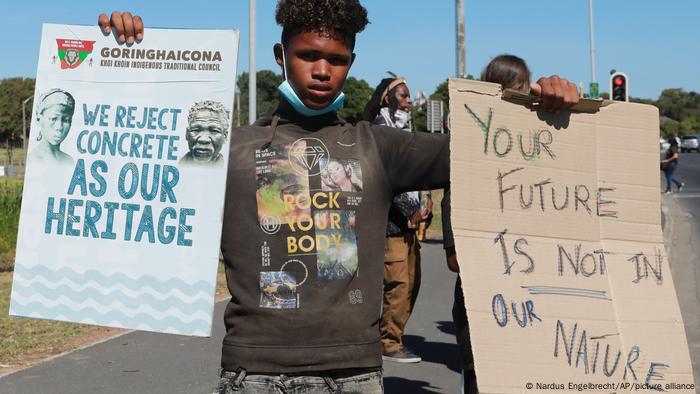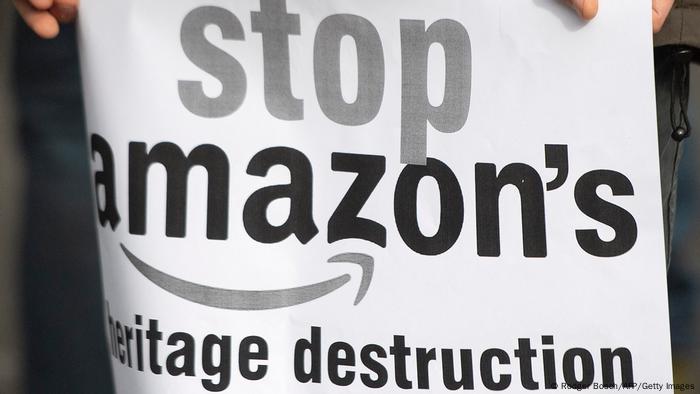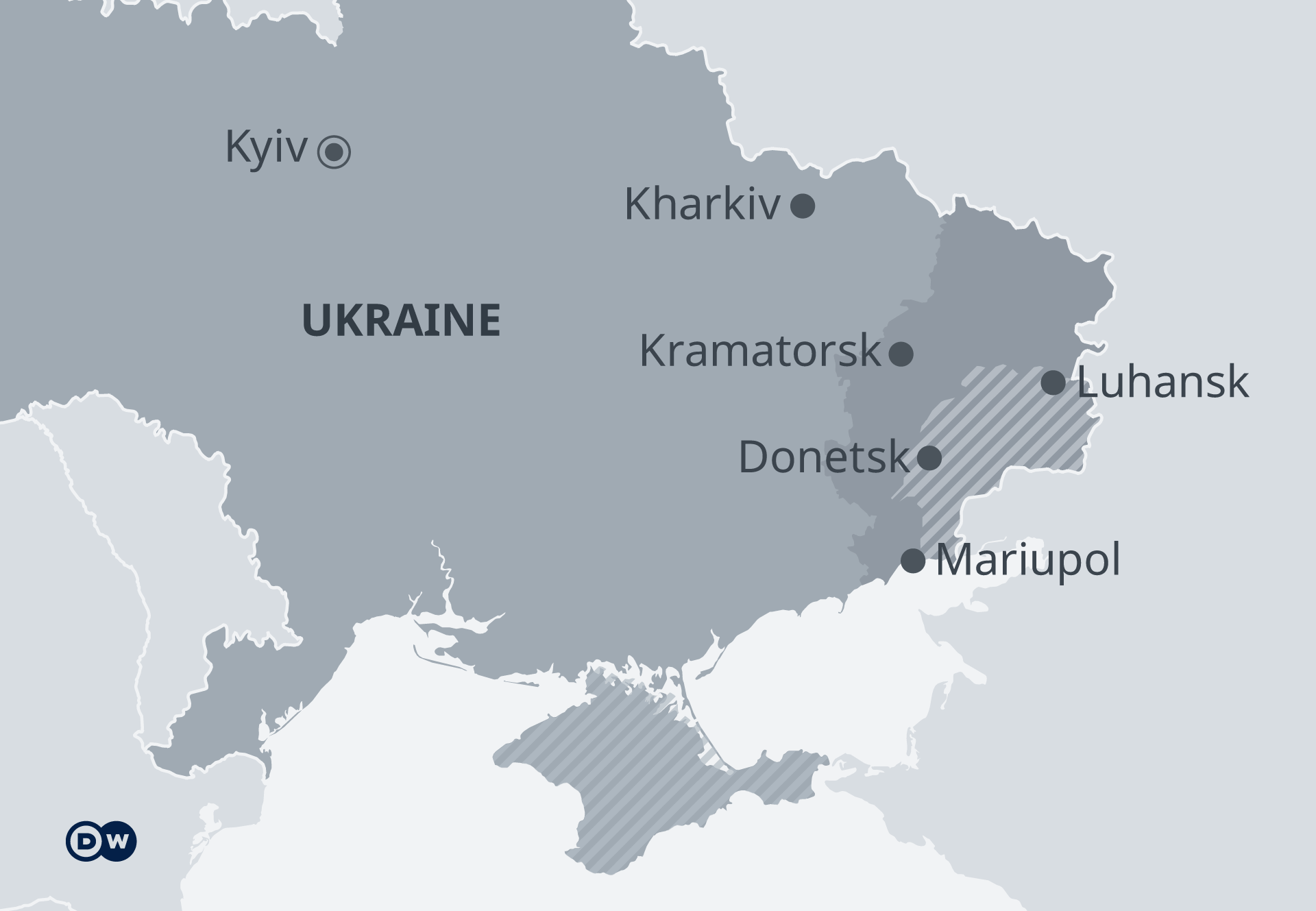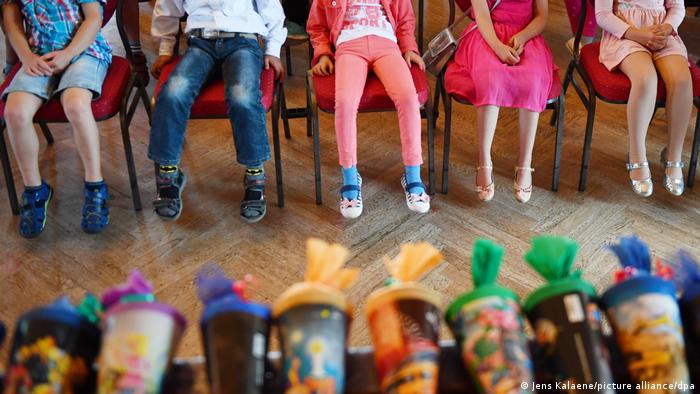When capitalism and Indigenous rights collide
A legal dispute involving retail giant Amazon and Indigenous South Africans has highlighted a global dilemma: Are sacred sites more important than job creation? Indigenous groups have been fighting back.

Protests such as this led to the suspension of the Amazon project in Cape Town
The River Club development was under construction on sacred land, the spiritual home to the Khoi and San ethnic groups — the earliest inhabitants of southern Africa. And it lies in the middle of one of South Africa's most important metropolitan regions.
Online retail giant Amazon's Africa headquarters was planned for the development, which lies at the confluence of the Black and Liesbeek rivers.
But, now, the cranes are at a standstill, and the High Court in Cape Town has banned work from continuing until the Indigenous peoples affected are meaningfully involved. They are protesting and demanding a definitive halt to the €260 million ($283 million) project.
"Jeff Bezos, the richest man in the world with his Amazon headquarters on our sacred land!" Bradley van Sitters, a Khoisan activist, told DW.
"For him to build this African headquarters is a great shame. This river is sacred to us," van Sitters said, adding that it was where the groups went to hold ceremonies and rituals.
"We also want to bring our children here. This must be declared a world heritage site," van Sitters said.
Historical significance
The Khoisan people associate fond memories with the land at the foot of Cape Town's Table Mountain.
In the early 16th century, invading Portuguese troops were repelled by the Khoi and San peoples on that same site. Some 150 years later, the Indigenous people resisted the Dutch settlers who began their land expropriations from the river.
But the project could also be an opportunity for Cape Town. Amazon already employs thousands of people at various data processing centers in the city.
Once completed, the new complex is expected to provide jobs for at least 1,000 people — and many more would have received employment during the construction phase.
Apart from the Amazon headquarters, homes, retail stores and offices are to be constructed on the site. In a written statement, the US-based multinational e-commerce company said that the majority of the Cape's Khoi and San people support the development.
Amazon's bid to honor Indigenes
To honor the heritage of the Khoi and San, the developers said they had planned a media center, a "heritage garden" and an amphitheater.
"The small group of activists opposing the River Club project have been spreading falsehoods about the current property, the redevelopment, and the impact on intangible heritage, the environment and biodiversity," Liesbeek Leisure Properties Trust said in a statement.
According to Statistics South Africa (Stats SA), South Africa's unemployment rate is 35.3%. Furthermore, the youth unemployment rate has remained stubbornly high at 65.5%.
South African President Cyril Ramaphosa has been seeking to woo foreign investment to create job opportunities.
But that should not happen at the expense of Indigenous peoples, said Genevieve Rose, head of the African Commission on Human and Peoples' Rights (ACHPR).
"We are not saying that development is not important. Indigenous peoples would also like to have electricity. They also need jobs," Rose told DW.
"But the reality is that their land is being taken away — they're not being consulted. They are not getting information in their language. They don't get real jobs," Rose said.
"If they are relocated, it's to worse land," Rose said, "and they are worse off than before."
Call for recognition
The only thing Indigenous peoples would ask for, Rose said, is for their rights to the land where the development is taking place be recognized and that they are given proper consideration.
"Then they can participate constructively in the project and try to find a solution that works for them and that they also benefit from. But right now, that's not the case," Rose said.
Similar scenarios have happened elsewhere in Africa. For example, in the 1970s, the Kenyan government evicted hundreds of Endorois families from their land to create a wildlife sanctuary for tourists.
The Endorois filed and won a lawsuit. In 2010, the ACHPR ruled that the Kenyan government had violated the Endorois' rights to religious worship, property, culture, free disposal of natural resources, and development. It recommended recognizing property rights, returning ancestral lands to the Endorois, compensating them for their losses, and ensuring that the Endorois benefit from the game reserve employment opportunities.
But, according to the International Network for Economic, Social and Cultural Rights (ESCR-Net), Nairobi has largely ignored the recommendations so far.

Kenya's Endorois people won a legal battle to be compensated for their land
Indigenous and corporate collaboration
"Governments, especially in sub-Saharan Africa, must first recognize that Indigenous peoples live on the land and also have traditional ownership of that land," Rose said.
"That many governments don't want to recognize these people is a problem in itself," Rose said, adding that recognition means giving them the right to the land. "You can't sell the land or get these investment projects. So they prefer not to recognize their existence or the fact that they own the land as a community."
Batwa land has also been converted into national parks and forest reserves against their will in Burundi and Uganda. And in Ethiopia, pastoralist peoples were forced off their land so foreign and national companies could lease it. Rose also sees these companies as having a role to play.
"Companies can have a really big impact and put pressure on the government that they're not going to do business unless these people are involved in the whole process," Rose said.
That includes figuring out what the land means to the people, calculating fair compensation and establishing how to offer them work in the long term, she said.
Adequate compensation
Then, cases like the one in Kenya and its Lake Turkana Wind Project (LTWP) would not arise.
In a historic ruling in 2021, the Kenyan Environment and Land Court in Meru declared the title deeds to the land on which the LTWP stands "irregular and unlawful."
Indigenous people had complained that the wind energy project did not obtain consent, did not pay adequate compensation and violated applicable land laws.
The court gave the county government one year to correct the process, or the land would revert to the community.
Mali Ole Kaunga, director of the Indigenous Movement for Peace Advancement and Conflict Transformation (IMPACT), described the ruling as a victory for the El Molo, Turkana, Samburu, and Rendille communities.
He also praised the ruling as a win for "all Kenyan communities at risk of displacement and human rights violations from large-scale land investments."
What could help an Indigenous community, Rose said, is to have its protocols in place in case a company comes onto its land.
Rose said she is confident that cooperation is possible with a fair compromise for both sides. But she stressed that, above all, recognition is critical.
Okeri Ngutjinazo and Adrian Kriesch contributed to this article
Edited by Keith Walker.
















